How to Screen Mirroring Android to PC/Mac
Screen mirroring on your Android phone allows you to stream the contents of your phone screen to your Windows PC or Mac. This guide walks you through the steps to set this up on both your phone and your computer.
Screen Mirroring & AirPlay Tips
Screen Mirroring Tips & Apps
iPhone/Android Mirroring
Screen mirroring is one of the best things to ever happen to presenters. It allows you to view your Android or iPhone the contents on a larger screen. This way, if you are having trouble viewing any objects on the small screen of your phone, you can mirror your phone to your computer and view your content on a really large screen.
Most Android phones come with the ability to help you mirror your device to a compatible computer. And there are two convenient methods to achieve this feat: wirelessly and via USB. In this article, we will explore these two approaches, providing you with a clear understanding of how to effortlessly mirror your Android device to your PC. Whether you prefer the convenience of wireless connectivity or the reliability of a wired connection, this guide will equip you with the necessary knowledge to successfully mirror your Android screen.
Further Reading: How to Stream Android Phone Screen to OBS with Ease >
How to Mirror Android Screen on Computer with USB
Compared to using WiFi to mirror Android phones to PC, the method of USB mirroring (screen mirroring without WiFi) has one significant advantage, which is it can promise a more stable connection.
Lag or latency is one of the primary concerns that users care about when mirroring mobile phones to PCs. While wireless connection sets users free from cables and distance, it also may suffer from frequent disconnections or poor signal strength.
AnyMiro is a screen mirroring app for Android and iPhone that supports both USB mirroring and wireless mirroring. What makes it stand out is that AnyMiro has enhanced its ability to provide a smooth and responsive connection. To help you decide faster, here are some of the features that make AnyMiro better than similar products:
- Audio/Video Sync: AnyMiro uses the powerful FFmpeg audio and video codec technology to solve the problem of audio and video being out of sync that often occurs during screen mirroring.
- 4K Resolution: Low display resolution or a reduced image quality often bothers screen mirroring app users a lot. AnyMiro works really hard to promise a 4k resolution quality, make sure what you see on your Android is what you get on your computer.
- No Latency: By applying reliable USB 3.0 transmission technology, AnyMiro can control the latency between your phone and computer below 10 ms, which is a huge progress in the screen mirroring market.
Follow the guide here to see how to mirror Android to PC with AnyMiro:
*With this method you need to download both the AnyMiro software and the mobile app.
Step 1. Download to get the AnyMiro desktop version, and enter the Android mirroring path.
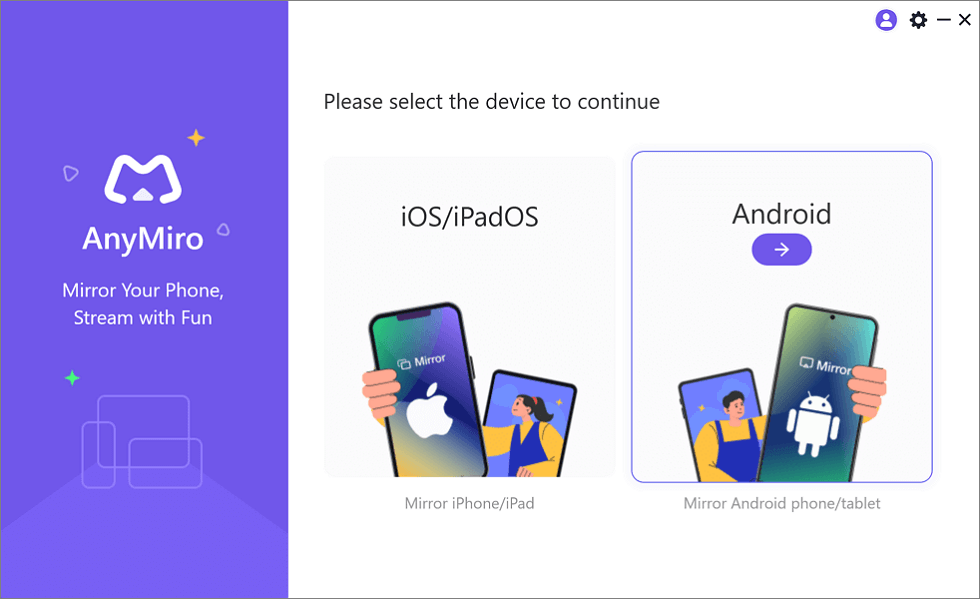
Mirror Android to Computer
Step 2. Enable USB debugging of your Android phone. If you don’t know how to do it, there is a guide inside AnyMiro tells you how.

Mirror Android to Computer via USB
Step 3. Then open the AnyMiro app on your phone, tap Start in USB connection, and wait a few seconds, you can see your Android screen on your PC.
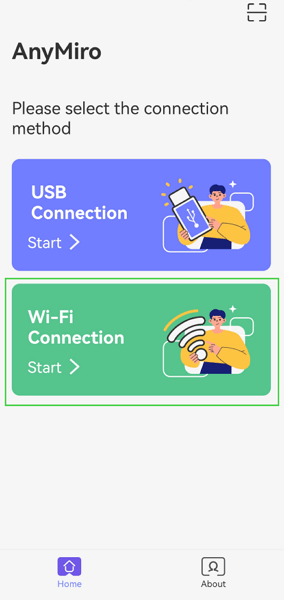
Select the Connection Method
Check the video guide on YouTube and see how AnyMiro works on screen mirroring to PC.
How to Mirror Android to PC Wirelessly
When it comes to mirroring your Android device’s screen on your PC, the wireless method offers a convenient and hassle-free solution. With this method, you can transmit your Android screen onto a PC display without the need for any physical connections. But there is one thing you need to pay attention to. This method requires your Android phone and your PC to connect to the same WiFi, and that is also the key to a successful connection. Now, let’s dive into the step-by-step process of mirroring Android to PC wirelessly.
The tool you can use here is AnyMirror. It is a light and stable screen mirroring tool that supports Android, iOS, Windows, and Mac. AnyMirror does not require your computer to install the Miracast package. As long as your PC and your Android are connected to the same WiFi, AnyMirror can help you to cast the Android screen to your PC.
Step 1. Download AnyMirror on your computer > Then search AnyMirror in Google Play and download it on your phone.
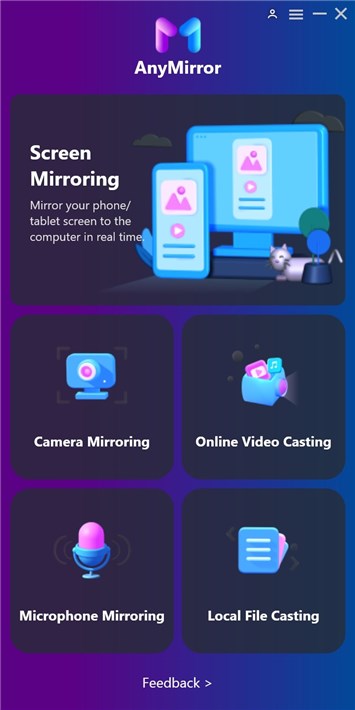
Select Function on AnyMirror
Step 2. Launch AnyMirror and connect your Android phone to the computer by scanning the QR code> Choose Screen Mirroring on your computer and tap on OK.
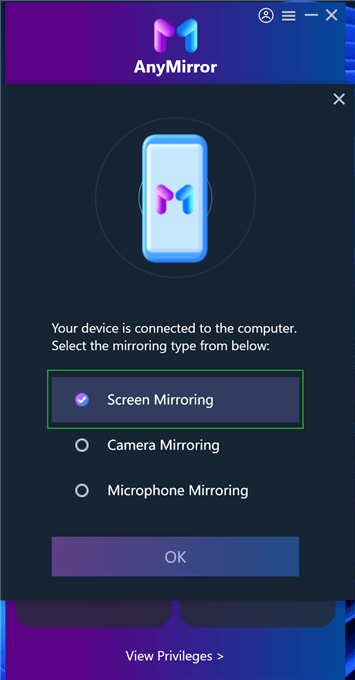
Choose Screen Mirroring On Computer
Step 3. When your Android is detected by AnyMirror, you can see the interface below. Then you can go to any screen that you want to mirror to the computer. In addition, you can draw on the screen, record the screen, take a screenshot, and make other operations.
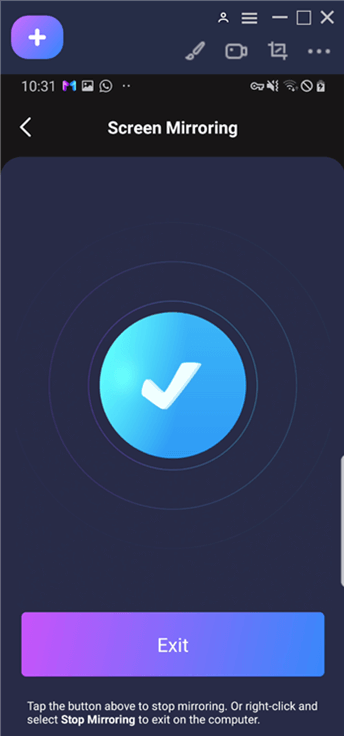
Succeed to Mirror the Android Phone
AnyMirror can also mirror your iPhone screens, audio, cameras, and microphone to a PC/Mac computer. You can follow the guide to mirror iPhone to PC or mirror iPhone to Mac.
AnyMirror also supports cast Android screen to Windows 7, Windows 10, and Windows 11, macOS 11 (macOS Big Sur), 10.15 (macOS Catalina), 10.14 (macOS Mojave), Mac OS X 10.13 (High Sierra).
How to Mirror Android to Windows 10/11
On some Windows PCs, there is a built-in Miracast feature that enables users to mirror and project other devices to the PC. If your device support Miracast, you can use this way to check and try if you can cast to your PC wirelessly with the built-in tool. Try these steps and see if you can mirror the Android screen to PC without third-party tools.
Step 1. Go to Start > Settings > Project to this PC on your Windows computer.
Step 2. If your PC supports Miracst, you can see all the option areas are available. Select Optional features under Add the “Wireless Display” optional feature to project to this PC.
Step 3. Select Add a feature, then enter “wireless display.”
Step 4. Select the check box next to Wireless display and click Install.
Step 5. After finishing the installation, go to “Project to this PC” again to set mirroring preferences.
Step 6. Launch the Connect app on your computer to mirror another screen.
How to Mirror Your Android to a Chromebook
Chromebook is a laptop that runs ChromeOS as the operating system. As Chromebook has equipped with large cloud storage and Google built-in, it gets more and more popular in recent years. There are a nice set of apps available for your Chromebook to let you mirror your Android phone. In this guide, we use one of these apps to accomplish the task.
AirDroid makes it extremely easy for you to mirror your Android screen to your Chromebook. The great thing about this app is that you do not even need to install the desktop client if you want. The app can be run off a web browser such as Google Chrome and you can view your phone’s screen in your browser. Let’s see how it works.
Step 1. Head to Menu > Settings > Developer options and enable the USB debugging option on your device.
Step 2. Download and install the AirDroid app on both Windows PC and Android devices.
Step 3. Launch the app on both of your devices. On your PC, click on the binocular icon and select Non-Root at the top.
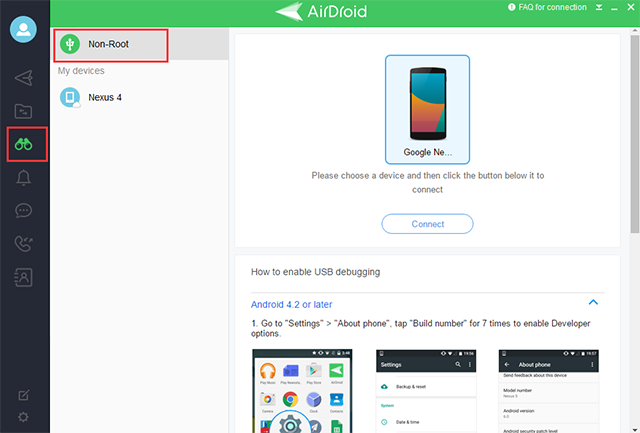
Mirroring Android to PC using AirDroid
Step 4. Tap on Start Now on your phone to start mirroring the screen to your computer.
You should be able to view the screen of your Android device on your Chromebook.
How to Screen Mirroring Android to Mac
If you want to mirror your Android to a Mac, you also have multiple methods available to do the task.
ApowerMirror is an app that allows you to easily mirror the screen of both your iOS and Android phones to your Mac machine. The app provides screen recording and screenshot features as well should you want to use them during your mirror sessions.
It is pretty easy to use the app to mirror an Android to a Mac and the following shows how you go about doing it on your machine.
Step 1. Turn on USB debugging from Menu > Settings > Developer options on your Android device.
Step 2. Download and install ApowerMirror on both your Mac and your Android phone.
Step 3. Launch the app on both of your devices. On your Android phone, tap on the button that says Start Now to start mirroring your device to your Mac.
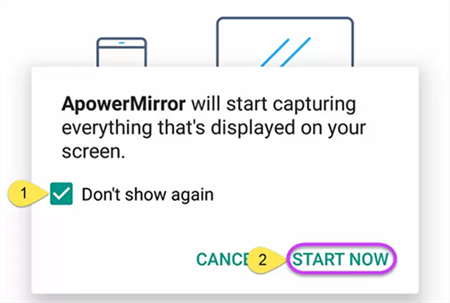
Mirroring Android to Mac using ApowerMirror
You will see your Android phone’s screen is mirrored to your Mac in real-time. If you want to stop the feature at any point in time, simply close the app on both your Mac and your Android phone. It will reset the connection.
You May Like: How to Screen Mirroring iPhone/Android to Roku?
FAQs about Android to PC Screen Mirroring
1. What is the best screen mirroring app for Android to PC via USB free?
The competition in the screen-casting software market is fierce. Once the screen-casting software cannot provide a good user experience, users’ trust and loyalty to it will decrease. It’s hard to judge which one is the best screen mirroring app. But you should have a try on AnyMiro.
AnyMiro is a light but powerful screen mirroring tool that prepares for all live streamers. To promise a steady live-streaming experience, AnyMiro has enhanced its ability to provide a stable and responsive connection. In terms of color display, which is ignored by all other products, AnyMiro is also committed to ensuring you the best color accuracy. What’s more, AnyMiro outperforms other apps by providing real-time audio and video sync. And it is perfectly compatible with most of the mainstream live-streaming platforms.
2. How can I display my phone from USB?
With the help of screen mirroring software like AirDroid, ApowerMirror, and AnyMiro, you can display the screen of your phone on a PC. You need to download and install the screen mirroring software on your computer, connect your phone to the computer using the USB cable, and then choose to mirror your phone’s screen via USB from the screen mirroring software.
The Bottom Line
There are a number of uses of screen mirroring and it is a really good idea to learn how you can use it from your Android phone to your Windows PC or Mac machine. Our guide above explains the procedure for both platforms so you can get started without wasting any time.
More Related Articles
Product-related questions? Contact Our Support Team to Get Quick Solution >

